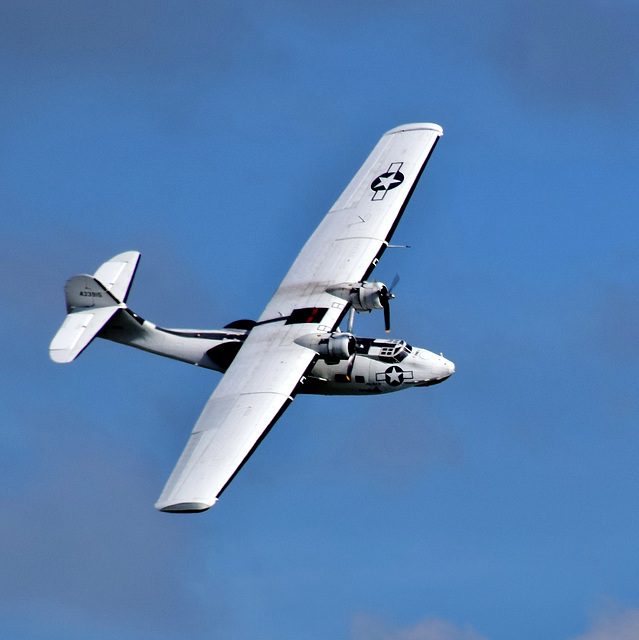Flying Fortress & Mustang at Duxford
Avro Vulcan XH558
Spifire MK 1a
Mustang P-51D
SEA VIXEN G-CVIX XP924 at Duxford
Bronco OV-10B at Duxford
The Red Arrows at Eastbourne 2022
Red Arrows
Embraer (Brazil) EMB-314 Super Tucano
East German Sukhoi Su-22M-4 (NATO: Fitter-K)
TiG[air] - Helo passing
C-130 [09] : low flying
P-51 Mustang
Czechoslovak MiG-15
Mikoyan-Gurevich MiG-17PF (NATO: Fresco D)
Hawker Sea Hawk Mk. 4
East German Mikoyan-Gurevich MiG-15 UTI
Fairey Gannet Antisubmarine aircraft
Spanish He 111 painted in WWII German scheme
Messerschmitt Me 163B Komet
West German North American F-86D Sabre
Czechoslovak MiG-15
F-100 Super Sabre
Hawker Hunter
See also...
Authorizations, license
-
Visible by: Everyone -
All rights reserved
-
355 visits
PBY-5A Catalina "Miss Pick Up"


Seen flying above the imperial war musem Duxford airfield.
PBY Catalina was an American and Canadian-built flying boat of the 1930s and 1940s. PB stands for Patrol Bomber, with Y being Consolidated Aircraft’s manufacturer identification. It could be equipped with depth charges, bombs, torpedoes, and .50 calibre machine guns and was one of the most widely used multi-role aircraft of World War II. The PBY Catalina was the most successful flying boat ever produced. First flown in March 1935, they were in production for over ten years and were designed and built by the American aircraft manufacturers, Consolidated Aircraft of San Diego, California. The Catalina in RAAF service, despite its vulnerability due to lack of speed, was a front line aircraft effectively taking the fight to the Japanese through its long distance mine laying flights.
The PBY was the first US aircraft to carry radar and fulfilled diverse missions including torpedo-bomber, transport and glider tug. Famous were the "Black Cat" Catalina’s which, painted matt black, roamed the western Pacific from December 1942 finding Japanese ships by radar at night and picking Allied survivors from ships and aircraft in boats and dinghies. RAAF Catalina’s were famous for their precision laying of mines in enemy water ways and harbours. In this role it performed a substantial contribution towards victory for the Allies in the Pacific War by blockading essential oil ports and closing the "back streets" to Japan.
About 3300 Catalinas were produced and several are still flying today as water bombers, flying geological surveys, carrying people, supplies and equipment to inaccessible areas and even flying sportsmen into remote areas for hunting and fishing.
The aircraft is powered by two Pratt & Whitney R-1830-92 Engines
Twin-row 14 cylinder Air-cooled Radials, 1,200 hp @ 2,700 rpm.
MY THANKS TO ALL WHO VISIT AND COMMENT IT IS APPRECIATED
PBY Catalina was an American and Canadian-built flying boat of the 1930s and 1940s. PB stands for Patrol Bomber, with Y being Consolidated Aircraft’s manufacturer identification. It could be equipped with depth charges, bombs, torpedoes, and .50 calibre machine guns and was one of the most widely used multi-role aircraft of World War II. The PBY Catalina was the most successful flying boat ever produced. First flown in March 1935, they were in production for over ten years and were designed and built by the American aircraft manufacturers, Consolidated Aircraft of San Diego, California. The Catalina in RAAF service, despite its vulnerability due to lack of speed, was a front line aircraft effectively taking the fight to the Japanese through its long distance mine laying flights.
The PBY was the first US aircraft to carry radar and fulfilled diverse missions including torpedo-bomber, transport and glider tug. Famous were the "Black Cat" Catalina’s which, painted matt black, roamed the western Pacific from December 1942 finding Japanese ships by radar at night and picking Allied survivors from ships and aircraft in boats and dinghies. RAAF Catalina’s were famous for their precision laying of mines in enemy water ways and harbours. In this role it performed a substantial contribution towards victory for the Allies in the Pacific War by blockading essential oil ports and closing the "back streets" to Japan.
About 3300 Catalinas were produced and several are still flying today as water bombers, flying geological surveys, carrying people, supplies and equipment to inaccessible areas and even flying sportsmen into remote areas for hunting and fishing.
The aircraft is powered by two Pratt & Whitney R-1830-92 Engines
Twin-row 14 cylinder Air-cooled Radials, 1,200 hp @ 2,700 rpm.
MY THANKS TO ALL WHO VISIT AND COMMENT IT IS APPRECIATED
Vicente López García, J. Gafarot, , volker_hmbg and 5 other people have particularly liked this photo
- Keyboard shortcuts:
Jump to top
RSS feed- Latest comments - Subscribe to the comment feeds of this photo
- ipernity © 2007-2025
- Help & Contact
|
Club news
|
About ipernity
|
History |
ipernity Club & Prices |
Guide of good conduct
Donate | Group guidelines | Privacy policy | Terms of use | Statutes | In memoria -
Facebook
Twitter

www.ipernity.com/doc/philsutters/25909203/in/group/341653
John Lawrence has replied to Phil Sutters clubI startet posting airplane pictures in my second account:
www.ipernity.com/doc/hh-volker2/album/1314518
Sign-in to write a comment.